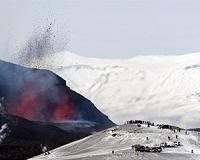| . |  |
. |
Reykjavik (AFP) April 14, 2010 A volcanic eruption in Iceland fired ash across northern Europe forcing the closure of huge swathes of international airspace on Thursday which grounded hundreds of flights. The eruption of the Eyjafjallajokull volcano in southeast Iceland had already melted part of a surrounded glacier causing severe floods. More than 700 people were evacuated from their homes. A huge cloud of ash from the second major eruption in Iceland in less than a month blew eastwards across the Atlantic, closing major airports more than 1,000 miles (1,700 kilometers) away. Britain closed its airspace to all flights. Nearly every airport in Norway, Denmark and across northern Sweden also shut down, authorities announced. There was major disruption in Belgium, France, Finland, Germany and the Netherlands. More than 300 flights out of London's Heathrow and Gatwick airports and others in Britain were cancelled, including transatlantic services. British airport operator BAA said: "Following advice from the Met Office, the National Air Traffic Service has introduced restrictions to UK airspace this morning as a result of volcanic ash drifting across the United Kingdom from Iceland." Many flights from the rest of Europe to North America would have to be rerouted because they normally go through British airspace, officials said. The ash was about five-six miles (eight-10 kilometers) in the air and could not been seen from the ground. But experts said it was a danger to jet engines and restricted visibility. Icelandic airports remained open as wind was blowing ash away from the island. "Flights to and from Iceland are still ok. The wind is blowing the ash to the east," Hjordis Gudmundsdottir of the Icelandic Airport Authority told AFP. "It's amazing really," she said. "Things here should be fine for the next 12 hours at least, and we think probably all day, judging from the weather forecast." The volcano on the Eyjafjallajokull glacier in southern Iceland erupted just after midnight on Wednesday. Smoke coming out of the top crater stacked more than 20,000 feet (6,000 metres) into the sky, meteorologists said. Icelandic public broadcaster RUV reported that a 500-metre fissure had appeared at the top of the crater on Wednesday. Lava melted the glacier, causing major flooding which forced the evacuation of between 700 and 800 people. Evacuees were being directed to Red Cross centres. "We have two heavy floods coming out from the melting of the Eyjafjallajokull glacier," police spokesman Roegnvaldur Olafsson told AFP from near the site of the eruption late Wednesday. The eruption in a remote area about 125 kilometres (75 miles) east of Reykjavik was bigger than the blast at the nearby Fimmvorduhals volcano last month. "It is very variable how long these eruptions last. Anywhere from a few days to over a year," Magnus Tumi Gudmundsson, a professor of geophysics and civil protection advisor in Iceland, told AFP. "Judging from the intensity of this one, it could last a long time," he added. Olafur Eggertsson said he had been forced to evacuate his farm, which lies in the path of one of two large floods of melt water coming from the glacier. "At around 10:30 this morning we heard a lot of noise and saw mud and soil suddenly rushing down from the mountain. Just 30 minutes later we had mud and soil and a giant flood running into our dyke above the farm," Eggertsson told AFP. "So in just a half hour, mud and soil came cascading down the mountain, down to our farm and on to the national highway that lies just beneath our farm. That is a total of four kilometres (2.5 miles) in just 30 minutes," he said. His family left all their animals behind in the rush to escape. "We have 200 animals on our farm: cows and sheep who are all inside now. It takes some time for the dykes to be destroyed and I don't know yet if they are in danger, but we are extremely worried," he said. Last month, the first volcano eruption at the Eyjafjallajokull glacier since 1823 -- and Iceland's first since 2004 -- briefly forced 600 people from their homes in the same area. That eruption at the Fimmvorduhals volcano, which gushed lava for weeks, ended Tuesday, experts said.
Share This Article With Planet Earth
Related Links Bringing Order To A World Of Disasters When the Earth Quakes A world of storm and tempest
 Iceland volcano eruption melts glacier, causes floods
Iceland volcano eruption melts glacier, causes floodsReykjavik (AFP) April 14, 2010 Iceland's second volcano eruption in less than a month melted part of a glacier and caused heavy flooding on Wednesday, forcing up to 800 people to evacuate and grounding some flights over Norway. "We have two heavy floods coming out from the melting of the Eyjafjallajokull glacier," local police spokesman Roegnvaldur Olafsson told AFP from near the site of the eruption in the south of the c ... read more |
|
| The content herein, unless otherwise known to be public domain, are Copyright 1995-2010 - SpaceDaily. AFP and UPI Wire Stories are copyright Agence France-Presse and United Press International. ESA Portal Reports are copyright European Space Agency. All NASA sourced material is public domain. Additional copyrights may apply in whole or part to other bona fide parties. Advertising does not imply endorsement,agreement or approval of any opinions, statements or information provided by SpaceDaily on any Web page published or hosted by SpaceDaily. Privacy Statement |